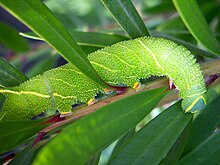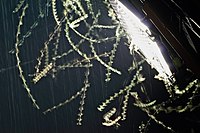Moth
| Moths | |
|---|---|

| |
| Emperor Gum Moth, Opodiphthera eucalypti | |
| Scientific classification | |
| Kingdom: | |
| Phylum: | |
| Class: | |
| Order: | |
A moth is an insect closely related to the butterfly, both being of the order Lepidoptera. The differences between butterflies and moths are more than just taxonomy. Sometimes the names "Rhopalocera" (butterflies) and "Heterocera" (moths) are used to formalize the popular distinction. Many attempts have been made to subdivide the Lepidoptera into groups such as the Microlepidoptera and Macrolepidoptera, Frenatae and Jugatae, or Monotrysia and Ditrysia. Failure of these names to persist in modern classifications is due to the fact none of them represents a pair of "monophyletic groups". The reality is that butterflies are a small group that arose from within the "moths"[citation needed] and there is thus no way to group all of the remaining taxa in a monophyletic group, as it will always exclude that one descendant lineage.
Most species of moth are nocturnal, but there are crepuscular and diurnal species. They can be distinguished from butterflies in several ways.
Etymology
The Modern English word "moth" comes from Old English "moððe" (cf. Northumbrian "mohðe") from Common Germanic (compare Old Norse "motti", Dutch "Mot" and German "Motte" all meaning "moth"). Perhaps its origins are related to Old English "maða" meaning "maggot" or from the root of "midge" which until the 16th century was used mostly to indicate the larva, usually in reference to devouring clothes.
The study of butterflies and moths is known as lepidoptery, and biologists that specialize in either are called lepidopterists. As a pastime, watching butterflies and moths is known as butterflying and mothing. The latter has given rise to the term "mother" for someone who engages in this activity — sometimes written with a hyphen (moth-er) to distinguish it from its usual meaning. This confusion does not arise in speech as it is pronounced differently (/ˈmɒθɚ/, not /ˈmʌðɚ/).
Economic significance of moths


Laothoe populi
Moths, and particularly their caterpillars, are a major agricultural pest in many parts of the world. The caterpillar of the gypsy moth (Lymantria dispar) causes severe damage to forests in the northeast United States, where it is an invasive species. In temperate climates, the codling moth causes extensive damage, especially to fruit farms. In tropical and subtropical climates, the diamondback moth (Plutella xylostella) is perhaps the most serious pest of brassicaceous crops.
Several moths in the family Tineidae are commonly regarded as pests because their larvae eat fabric such as clothes and blankets made from natural proteinaceous fibers such as wool or silk. They are less likely to eat mixed materials containing artificial fibers. There are some reports that they can be repelled by the scent of wood from juniper and cedar, by lavender, or by other natural oils. However, many consider this unlikely to prevent infestation. Naphthalene (the chemical used in mothballs) is considered more effective, but there are concerns over its effects on human health. Moth larvae may be killed by freezing the items which they infest for several days at a temperature below −8 °C (18 °F).[1]
Moths are sturdy and usually are more resistant to pesticides than are mosquitoes and flies.[citation needed]
Some moths are farmed. The most notable of these is the silkworm, the larva of the domesticated moth Bombyx mori. It is farmed for the silk with which it builds its cocoon. As of 2002[update], the silk industry produces over 130 million kilograms of raw silk, worth about 250 million U.S. dollars, each year.[2][3][4] Not all silk is produced by Bombyx mori. There are several species of Saturniidae that are also farmed for their silk, such as the Ailanthus moth (Samia cynthia group of species), the Chinese Oak Silkmoth (Antheraea pernyi), the Assam Silkmoth (Antheraea assamensis), and the Japanese Silk Moth (Antheraea yamamai).
The mopane worm, the caterpillar of Gonimbrasia belina, from the family Saturniidae, is a significant food resource in southern Africa.
Despite being framed for eating clothing, most moth adults do not eat at all. Most like the Luna, Polyphemus, Atlas, Prometheus, Cercropia, and other large moths do not have mouths. When they do eat, moths will drink nectar. Only one species of moth eats wool.[citation needed] The adults do not eat but the larvae will eat through wool clothing.
Attraction to light

Moths frequently appear to circle artificial lights. One hypothesis advanced to explain this behavior is that moths use a technique of celestial navigation called transverse orientation. By maintaining a constant angular relationship to a bright celestial light, such as the Moon, they can fly in a straight line. Celestial objects are so far away, that even after travelling great distances, the change in angle between the moth and the light source is negligible; further, the moon will always be in the upper part of the visual field or on the horizon. When a moth encounters a much closer artificial light and uses it for navigation, the angle changes noticeably after only a short distance, in addition to being often below the horizon. The moth instinctively attempts to correct by turning toward the light, causing airborne moths to come plummeting downwards, and - at close range - which results in a spiral flight path that gets closer and closer to the light source.[5]
This article needs additional citations for verification. (August 2007) |
In 1972, Henry Hsiao, now a professor of biomedical engineering, suggested that the reason for moths circling lights may have to do with a visual distortion called a Mach band.[6] He says that they fly towards the darkest part of the sky in pursuit of safety and are thus inclined to circle ambient objects in the Mach band region. This hypothesis is not scientifically accepted and has never been confirmed.[citation needed]
Hsaio says that the celestial navigation theory should cause moths to circle lights, not to head directly toward them, as many are seen to do. He conjectures that moths, which are nocturnal creatures, must find a place to hide from predators when daylight comes, but cannot do so in darkness. Their instinct when morning comes is to fly toward the light (presumably up) and then down again, with some probability landing on a surface which matches their camouflage.[5]
A theory which has been advanced in an attempt to explain the attraction male moths have for candles specifically is based on olfaction. There is evidence that olfaction might be, in some cases, mediated by detection of the infra-red spectra of substances.[7] The spiky infrared spectra of a candle flame happens to contain a number of emission lines which coincide with the vibrational frequencies of the female moth's pheromone.[8] The male moth is thereby powerfully attracted to the flame. Sources, eg. hurricane lamps, with different spike patterns are less powerful attractants.
Night-blooming flowers usually depend on moths (or bats) for pollination, and artificial lighting can draw moths away from the flowers, affecting the plant's ability to reproduce. A way to prevent this is to put a cloth or netting around the lamp. Another way is using a colored light bulb (preferably red). This will take the moth's attention away from the light while still providing light to see by.
Predators of moths
Nocturnal insectivores often feed on moths; these include some bats, some species of owls, but also other species of birds. Moths are also eaten by some species of lizards, some cats, some dogs, some rodents, and some bears. Moth larvae are vulnerable to being parasitized by ichneumonidae.
Notable moths
- Atlas moth (Attacus atlas), the largest moth in the world
- White Witch moth (Thysania agrippina), the Lepidopteran with the biggest wingspan
- Madagascan Sunset moth (Chrysiridia rhipheus), considered to be one of the most impressive and beautiful Lepidoptera[9]
- Death's-head hawkmoth (Acherontia spp.), is associations with the supernatural and evil and was featured in art and movies
- Peppered moth (Biston betularia), the subject of a now well-known study in evolution
- Luna moth (Actias luna)
- Emperor Gum moth (Opodiphthera eucalypti)
- Polyphemus moth (Antheraea polyphemus)
- Bogong moth (Agrotis infusa), south eastern Indigenous Australians were known to have feasted on the moths.
Moths of economic significance:
- Gypsy moth (Lymantria dispar), a pest of hardwood trees in North America
- Corn earworm or cotton bollworm (Helicoverpa zea), a major agricultural pest
- Codling moth (Cydia pomonella), a pest mostly of apple, pear and walnut trees
- Light brown apple moth (Epiphyas postvittana), a highly polyphagous pest
- Silkworm (Bombyx mori), for its silk
See also
- Pollination
- Difference between a butterfly and a moth
- List of moths
- Lepidoptera
- Butterfly
- Clothing Moth
Gallery
-
Forester Moth
Zygaenidae -
A moth
-
Case Moth
Psychidae -
Case Moth
Psychidae -
Wood Boring Moth
Cossidae -
Dryocampa rubicunda Rosy Maple Moth
-
Grammia parthenice Tiger Moth
-
Nyctemera amica Arctiidae
-
Chelepteryx collesi Anthelidae
-
Lyssa zampa Uraniidae Grey Sunset Moth
-
Oldwife Underwing Catocala neogama
-
Hemaris thysbe Hummingbird Clearwing Moth
-
Underside of a moth
References
- ^ How to Manage Pests: Pests of Homes, Structures, People, and Pets
- ^ "Table 74. Raw silk: production (including waste)". Food and Agriculture Organization of the United Nations. Retrieved 2008-10-02.
Table lists worldwide raw silk production 132,400 metric tonnes in 2002
- ^ "Silk Exchanges of Tamil Nadu and Andhra Pradesh". Central Silk Board of India. [dead link] gives silk prices in rupees. Exchange rate is about 50 RS to dollar.
- ^ "Silk Worm Farming". Vegan Society. Retrieved 2008-10-02.
World Raw Silk Production in 1996 is listed as 83,670 metric tonnes
- ^ a b Why are Moths Attracted to Flame? (audio) All Things Considered, August 18 2007.
- ^ Henry S. Hsiao, Attraction of moths to light and to infrared radiation. San Francisco Press (1972) ISBN 0-911302-21-2
- ^ Wright, R. H., The Sense of Smell. CRC Press, London (1982)
- ^ Callahan, P.S., Moth and candle, Applied Optics 12, 3089-3097
- ^ Tait, Malcolm (2006-08-28). "1". Animal Tragic: Popular Misconceptions of Wildlife Through the Centuries. Think Books. p. 38. ISBN 184525015X. Retrieved 2008-02-19.
{{cite book}}: External link in|chapterurl=|chapterurl=ignored (|chapter-url=suggested) (help)
External links
- European Butterflies and Moths by Christopher Jonko
- Moths of North America Diagnostic large format photographs, taxonomy, descriptions
- North American Moth Photographers Group Diagnostic photographs for thousands of species
- Bugguide - Moths
- Back Garden Moths
- Life cycle photos of the salt marsh moth Estigmene acrea
- UK Lepidoptera
- Butterflies and Moths of the Netherlands
- Helicoverpa Diapause Induction and Moth Emergence Tool
- Pterophoridae of North America
- moths on the UF / IFAS Featured Creatures Web site















